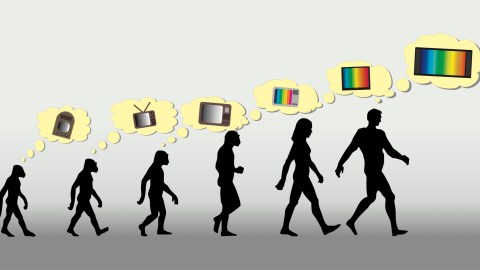John Seely Brown on Technological Evolution: Your iPad is Like an Arthropod

What’s the Big Idea?
How can we understand the dizzying rate of technological change and how can we develop the tools to best adapt to this change?
Learning guru John Seely Brown finds an intriguing analogy between the disruptive technology of today and what evolutionary biologists have observed in the fossil record during a period over 500 million years ago. The Cambrian period was like evolution on steroids. After a period of long evolutionary stasis, a warming climate created marine habitats that gave birth to new complex life forms. Among the great evolutionary innovations of this period were animals with external skeletons, or arthropods.
To follow Brown’s analogy, if anthropologists many years from now are to look at our current “Cambrian explosion” they will see that in the early 21st century human biology did not change so much. Instead, humans have co-evolved with technology, acquiring increasingly sophisticated tools in a short period of time. So how are we to master these tools? According to Brown, as human beings functioning in the 21st century knowledge economy today, we develop mastery through imagination and play.
Your iPod is like an arthropod.
“To be successful in this new type of Cambrian moment,” Brown tells Big Think in a recent interview, “imagination and play go hand-in-hand.” This is good news: you don’t need to spend your time reading and mastering user manuals for various gadgets and applications. Throw that classical education notion right out the door, says Brown. He continues:
Do you know anybody that goes back to school to learn how to use an iPad? Do you see anybody reading a manual like the old days to understand something? No. What do you do? The first thing you do is play with it. You see kids playing with it. You even see my cat playing with it.
What’s the Significance?
Imagination and play help us connect the dots, Brown says, which is something you will never accomplish through rote learning alone. What Brown is describing is a new form of education that has now become possible with Internet technology. In other words, use your iPhone 5 to “start thinking about new possible worlds.”
This fundamental shift is described in Brown’s most recent book, The New Culture of Learning: Cultivating the Imagination for a World of Constant Change. Brown says 21st century education needs to involve a willingness to say “Let me connect the dots but also let me tinker with the system.” That means “screwing up at times,” according to Brown, yet “if you feel comfortable with just playing with something,” he argues
pretty soon almost subconsciously you figure it all out. And so I think that in this period of radical change both imagination and play go hand-in-hand and if you can take learning on as an adventure, suddenly it becomes very exciting.
The type of learning that Brown describes is not only refreshing, fun and exciting, but necessary for survival in the 21st century knowledge economy. Let us remember, after all, that the Cambrian period that began as an explosion of new life forms also ended with a mass extinction. As glacial cooling and possibly oxygen depletion occurred, those that could not adapt died off.
Image courtesy of Shutterstock
Follow Daniel Honan on Twitter @Daniel Honan





